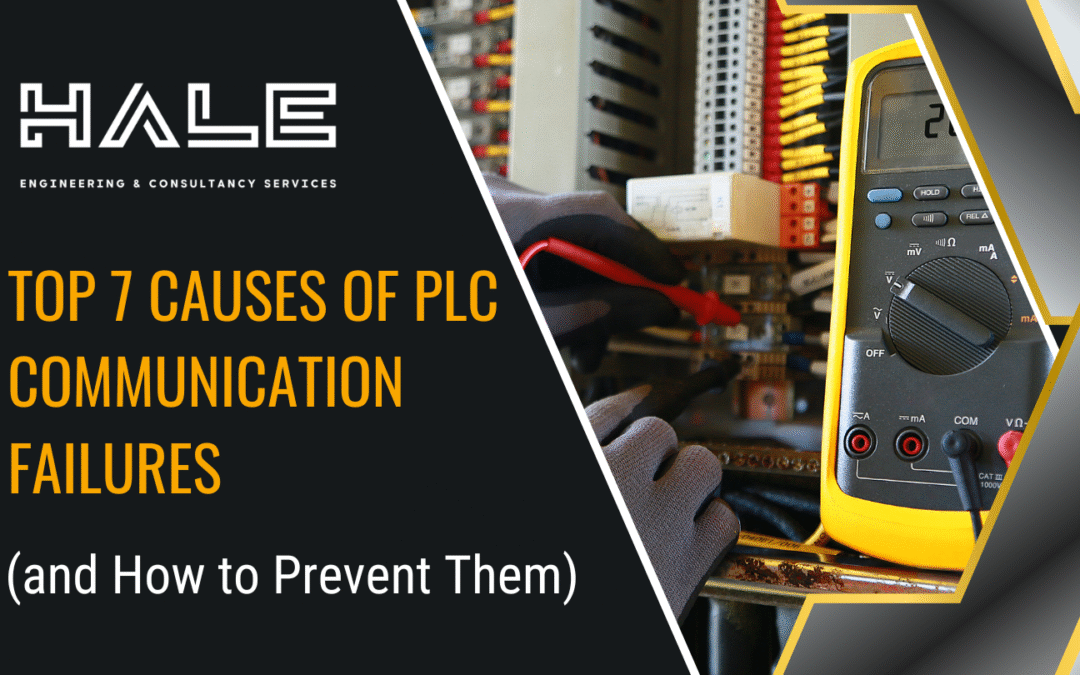When a programmable logic controller (PLC) stops communicating correctly, production doesn’t just slow down—it stops. Communication faults are among the most common yet costly issues in automated environments, often masking deeper system vulnerabilities.
At Hale Engineering, we’ve supported hundreds of industrial sites across the UK dealing with unexpected downtime and control issues. Many of these incidents trace back to preventable communication failures that, if addressed early, could have saved hours—or even days—of lost output.
In this article, we unpack the top seven causes of PLC communication breakdowns and explain how to prevent them through robust design, maintenance, and monitoring practices.
1. Network Cabling and Physical Layer Issues
Damaged or poorly terminated cables are one of the simplest yet most frequent causes of PLC communication loss. Loose connections, corrosion, and electromagnetic interference (EMI) can disrupt data signals, particularly in high-noise industrial environments.
Prevention:
Implement regular inspections and continuity tests. Use shielded cabling with proper grounding, and maintain clear separation from high-voltage power lines.
Our maintenance services include detailed diagnostics and root-cause reporting to identify physical network weaknesses before they become failures. We also design and install bespoke control panels with EMI-shielded layouts to ensure long-term signal integrity.
2. IP Address Conflicts and Network Configuration Errors
In Ethernet-based control systems, duplicated or incorrectly configured IP addresses can cause intermittent communication faults that are difficult to trace.
Prevention:
Maintain a master IP allocation map and ensure all devices follow standard naming and addressing conventions. Isolate automation networks from office IT networks where possible.
Our PLC & control systems team offers network design and HMI/SCADA integration to standardise configurations across sites. During a PLC Health Check, we verify network integrity and optimise communication protocols for stability and scalability.
3. Outdated Firmware and Software Incompatibility
As PLCs evolve, firmware updates address communication bugs, memory leaks, and protocol mismatches. Running outdated firmware can lead to random disconnections or diagnostic errors.
Prevention:
Establish a scheduled update regime, backed by verified backups and rollback plans.
We provide planned maintenance programmes that include firmware verification and upgrade testing. Our consulting arm assesses compatibility across Siemens, Allen-Bradley, Mitsubishi, and other platforms—minimising integration risks and ensuring consistent performance.
4. Excessive Network Traffic and Overloaded Switches
Adding new devices or expanding automation networks without recalculating load can overwhelm switches or PLC communication buffers, resulting in packet loss and latency.
Prevention:
Use managed switches, segment traffic through VLANs, and continuously monitor bandwidth utilisation.
Our bespoke engineering solutions include turnkey system design and installation with optimised network architectures. We ensure each component—from switches to PLCs—is configured to handle peak throughput with redundancy built in.
5. Poor Grounding and Electrical Noise
Electrical interference from variable-speed drives, welding systems, or heavy-duty motors can cause intermittent data errors. Improper grounding exacerbates the problem, affecting both analogue signals and digital communications.
Prevention:
Follow IEC 61439 and IEC 62061 grounding standards. Install line filters and maintain separate reference points for signal and power circuits.
We perform electrical testing and compliance checks aligned with PUWER and HSE standards, verifying that grounding and bonding meet safety and performance requirements. Our engineers also deploy thermal imaging and voltage integrity tests to detect hidden noise sources.
6. Environmental Stress: Temperature, Dust, and Vibration
Harsh industrial conditions can degrade connectors, loosen modules, and distort signals. Overheated panels and dust ingress often lead to recurring communication faults.
Prevention:
Maintain optimal cabinet temperatures, install vibration-resistant mounts, and conduct quarterly environmental inspections.
Our routine inspections and PPM services include full enclosure health checks. For extreme environments, we design custom-built control panels with enhanced cooling, dust protection, and vibration isolation to preserve long-term system reliability.
7. Inadequate Documentation and Training
Even the best-designed system can fail if operators lack up-to-date documentation or training. Incorrectly applied changes—like moving a PLC to a new IP range without updating dependencies—can disrupt entire networks.
Prevention:
Maintain centralised configuration records, document all program changes, and provide refresher training for maintenance staff.
Every Hale Engineering consulting project includes clear, traceable documentation and operator briefings. We also help clients develop internal maintenance checklists and training materials to ensure consistent knowledge retention.
Building Resilient Automation Systems
PLC communication failures rarely occur in isolation—they’re often symptoms of wider system weaknesses. That’s why Hale Engineering takes a holistic approach: assessing the full lifecycle of your automation infrastructure from hardware to software and safety compliance.
Through our PLC Health Check Package, we offer:
-
Diagnostic assessment of communication networks
-
Performance analysis and firmware review
-
Backup and restoration strategy validation
-
Compliance and safety system alignment
-
Clear, actionable recommendations for improvement
Contact Hale Engineering
Don’t wait for downtime. Whether you’re experiencing communication faults or planning a proactive upgrade, Hale Engineering delivers practical solutions that work—without the guesswork.
Contact Hale Engineering today to find out how our engineers can help strengthen your PLC network and future-proof your automation systems.
📞 +44 20 8154 6102
📧 info@hale-eng.co.uk
🌐 hale-eng.co.uk

